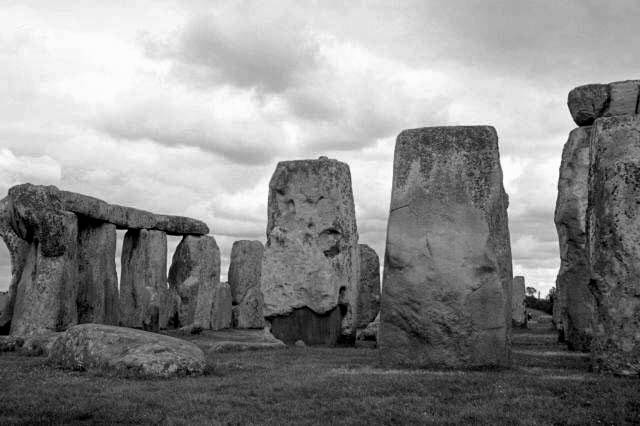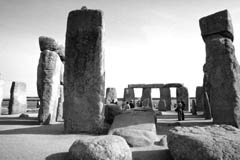|
 A
megalithic mystery A
megalithic mystery
Stonehenge is a magnificent Neolithic monument near
Amesbury, Wiltshire, built high on the windswept chalky Salisbury
Plain. It is now widely accepted that there were three constructional
phases, beginning around 2950 BC to 1500 BC.
The reason for Stonehenge remains a perplexing puzzle
- was it built as a pagan temple - a sacred place for ceremonies
or rites of worship involving the sun or moon, or intended as a calendar
or an astronomical observatory? Many long to find out about the Stonehenge
mystery or learn more about the ancient rites that were carried out
at Stonehenge by our ancestors.
The prehistoric stone circle was believed to have been
erected around 2600 BC, and in various stages. Archaeologists continue
to discover more about how these vast masses of stone were hauled
into place and when, but we will never really know what Stonehenge
was used for.
Stonehenge - Temple of the Sun
During the midsummer solstice we gaze out of the sacred circle to
see the sun rise over the Heel Stone, and the first rays shine into
the centre of the monument between the stones of the trilithon horseshoe.
Was this seen as a visual re-enactment of the sacred marriage between
Heaven and Earth? ...the Sun God's rays penetrating the Earth Mother
- the stone circle, with the Heel stone casting a powerful phallic
shadow.
Some believe the Heel, or Hele, stone - an outlying sarsen - was
originally part of a pair that was intended to perfectly frame the
midsummer sunrise. The Anglo Saxon verb 'helan' meaning 'to conceal'
could be connected with the naming of this stone - it conceals the
sun rising on the summer solstice.
At the midwinter solstice the setting sun sinks between
the two uprights of the largest trilithon and behind the altar stone
- thought by many to symbolize the death of the year. The shortest
day of the year would have been important to a community whose livelihood
depended heavily on agriculture. The winter solstice brought reassurance
that Spring would again follow, and that life and growth would continue.
There are many stellar correlations as well as the sun
and moon alignments at Stonehenge. There are solar alignment points
not only within the stone circle, but beyond these with the outlying
Heel and Slaughter stones.
Stonehenge - the ancient Lourdes
Timothy Darvill, professor of archaeology at Bournemouth
University, has recently revealed research that he believes shows that
Stonehenge was an ancient healing place. In his new book 'Stonehenge:
The Biography of a Landscape' the professor cites that human remains
excavated from burial mounds near Stonehenge, reveal that many of the
buried had been ill prior to their death. The remains also seem to
have come from far and wide, like the Amesbury Archer who originated
from what is now known as Switzerland. The professor believes that
Stonehenge would have been mainly used during the winter solstice,
when our ancestors believed it was occupied by Apollo, the Greek and
Roman god of healing. Layamon's poem, 'Brut', written around AD1215
seems to reinforce this use of Stonehenge, and is one of the earliest
megalithic poems.
The stones are great
And magic power they have
Men that are sick
Fare to that stone
And they wash that stone
And with that water bathe away their sickness
Lunar temple
Some believe that the early Stonehenge was re-aligned
into a solar monument instead of being a pointer for lunar movements.This
was apparently achieved by moving the entrance constructed thousands
of years before and re-aligning the axis, so the focus became solar.
The rising moon was believed to have been seen as a symbol
of ancestral spirits being liberated from their bones and earthly existence.
The lunar alignment becomes apparent with the most northerly rising
of the full moon at mid-winter.
The Altar Stone
This large stone is not a bluestone or sarsen. It is
micaceous sandstone - containing thousands of light reflective particles
of shiny mica. Though this important stone is now fallen and we can
only see the upper surface, when it was standing 3 metres high inside
the circle it may have acted like a mirror reflecting back the rays
when the midsummer sunrise shone into the centre of Stonehenge.
Was this intended as an offering of the energizing light and warmth back to
the Sun God from the people's temple?
Construction
Although Stonehenge is not the world's largest stone
circle (Avebury, constructed between 2800 and

2700 B.C.is the largest - 1,401 feet in diameter), it
is the only one that has horizontal lintels around the top.
'Stonehenge' is believed to be the Old English word for
'hanging stone'. The lintels are fixed end to end by tongue and groove
joints and firmly held on top of the standing sarsens with mortice
and tenon joints.
Such construction skill is one of the reasons that part
of the circle is still standing after thousands of years. Unlike other
stone circles Stonehenge reveals careful shaping, smoothing and tapering
of the stones. The outer circle's lintels are even curved to follow
the line. The Heel Stone is the only naturally shaped sarsen. Stonehenge
is more than a stone circle - it is architecture with aesthetic appeal,
and the wonder of Western Europe.
Bluestones
Another mystery is the use of bluestones - so called because they
look blue when wet - from the Preseli Mountains in South Wales. The
stones weighed up to 4 tons each and about 80 blocks and slabs were
used. They are believed to have been transported the 240 miles to Salisbury
Plain by roller and sledge on land, and on rafts along the coast. Perhaps
the stones came from another circle or their location was believed
to be of spiritual or magical importance, we can only guess.
Recently, archaeologists have - through isotope analysis of teeth
- discovered that three of the remains found in a 2,300 year-old grave
close to the Stonehenge site are most probably Welshmen, and were likely
to have been involved in the construction of the monument.
Druid connection

It is believed from the writings of Romans such as
Tacitus and Julius Caesar that the Druids were a priesthood of the
early Celtic religion. Archaeological findings date Stonehenge to
more than 1,000 years before the rise of Druidism.
However, in the 17th Century John Aubrey made the connection
of the ancient Druids to Stonehenge. This idea was very popular in
the Romantic Age and produced wonderful poems and paintings of Stonehenge.
Other antiquarians such as William Stukeley also suggested the evocative standing
stones were a Druidical temple. The connection persists with myths of Pagan
Slaughter Stone rituals - in reality believed by archaeologists to be a fallen
standing stone.
The gathering of the Druids from various orders during
the solstices at Stonehenge brings great interest from the public
and media. Their peaceful ceremonies enhance the sacredness and spiritualism
of this prehistoric temple, as like others they celebrate the powerful
energy of this noble monument.
'The Druid's
groves are gone - so much the better.
Stonehenge is not, but what the devil is it?'
Don Juan - Lord Byron, 1823
Aubrey Holes
Seventeenth-century antiquary John Aubrey discovered
a ring of fifty-six shallow pits - many containing cremated human
bones. The holes were evenly spaced and were about three feet deep.
Stonehenge mythology
The stones are believed to be petrified dancing giants who were
caught in a sunbeam. The stone circle is said to resemble the giants
holding hands, and in folklore is known as the 'Giants' Ring'.
The stones were renown for their healing properties. If you sat
under the stones and water was poured over them then your wounds
would be healed.
It is supposedly impossible to count all the stones. The devil once
bet that no one in the nearby village would be able to come up with
the right answer. However, a monk replied 'more than could be told'.
The devil angrily threw one of the stones at the monk and it bounced
off the back of his foot - the outlying stone was then named the
Heel Stone

Merlin and the Giants' Dance
In the 12th Century Geoffrey of Monmouth's History of the Kings
of Britain stated that the stones were originally brought from Africa
to Ireland by a race of giants. Later the wizard Merlin apparently
moved the standing stones - the 'Giants' Dance' as Geoffrey called
them - from Killaraus, a mountain in Ireland, to Salisbury Plain.
They were to provide 'an everlasting monument' to the nobles that
had been massacred by the Saxons.
People's Temple

The last man to own Stonehenge was Cecil Chubb - he purchased the
stones in 1915 for £6,600.
Three years later he made a gift of the stone circle to the nation, with the
proviso that admission to locals should be free. This continues today and includes
the residents of all the parishes of the former Amesbury Rural District. Close
visitor contact with the stones has been prohibited since 1978, apart from
the annual Open Access for the solstices and out-of-hours private visits -
where you can step inside the fenced path encircling the stones for a price.
Some suspect that Stonehenge was built for elite gatherings, as
experts believe that most sound would have remained inside the circle.
Perhaps the priests controlled a larger crowd by climbing up onto
the great trilithon where they could be seen and heard by all? We
can only guess at the motives behind the creation of Stonehenge's
colossal magnificence. It remains an amazing focal point in a landscape
of burial mounds and barrows - a ritual space and monument - a celebration
of man's abilities on earth.
No conclusive answers have solved the paradox of this evocative
megalithic art and it continues to fascinate generations remaining
one of the world's most important Neolithic sites. These immense
portals are a door to our past. The henge will remain a palpable
yet mystical connection. For many, the reason behind this awe-inspiring
creation does not matter - it belongs to us all, a 'people's temple'
- a place of sanctity, and remains the world's best-loved stone circle.
 
|

 A
megalithic mystery
A
megalithic mystery 




